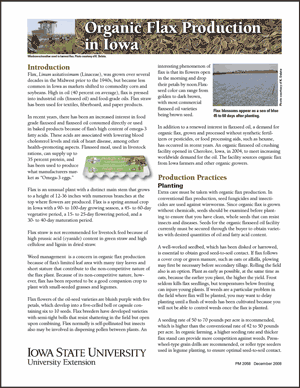Ames, Iowa
April 13, 2009Source:
Iowa State
University Extension
Introduction
 Flax,
Linum usitatissimum (Linaceae), was grown over several
decades in the Midwest prior to the 1940s, but became less
common in Iowa as markets shifted to commodity corn and
soybeans. High in oil (40 percent on average), flax is pressed
into industrial oils (linseed oil) and food-grade oils. Flax
straw has been used for textiles, fiberboard, and paper
products. Flax,
Linum usitatissimum (Linaceae), was grown over several
decades in the Midwest prior to the 1940s, but became less
common in Iowa as markets shifted to commodity corn and
soybeans. High in oil (40 percent on average), flax is pressed
into industrial oils (linseed oil) and food-grade oils. Flax
straw has been used for textiles, fiberboard, and paper
products.
In recent years, there has been an increased interest in food
grade flaxseed and flaxseed oil consumed directly or used in
baked products because of flax’s high content of omega-3 fatty
acids. These acids are associated with lowering blood
cholesterol levels and risk of heart disease, among other
health–promoting aspects. Flaxseed meal, used in livestock
rations, can supply up to 35 percent protein, and has been used
to produce what manufacturers market as “Omega-3 eggs.”
Flax is an unusual plant with a distinct main stem that grows to
a height of 12-36 inches with numerous branches at the top where
flowers are produced. Flax is a spring annual crop in Iowa with
a 90- to 100-day growing season, a 45- to 60-day vegetative
period, a 15- to 25-day flowering period, and a 30- to 40-day
maturation period.
Flax straw is not recommended for livestock feed because of high
prussic acid (cyanide) content in green straw and high cellulose
and lignin in dried straw.
Weed management is a concern in organic flax production because
of flax’s limited leaf area with many tiny leaves and short
stature that contribute to the non-competitive nature of the
flax plant. Because of its non-competitive nature, however, flax
has been reported to be a good companion crop to plant with
small-seeded grasses and legumes.
Flax flowers of the oil-seed varieties are bluish purple with
five petals, which develop into a five-celled boll or capsule
containing six to 10 seeds. Flax breeders have developed
varieties with semi-tight bolls that resist shattering in the
field but open upon combining. Flax normally is self-pollinated
but insects also may be involved in dispersing pollen between
plants. An interesting phenomenon of flax is that its flowers
open in the morning and drop their petals by noon.Flax-seed
color can range from golden to dark brown, with most commercial
flaxseed oil varieties being brown seed.
In addition to a renewed interest in flaxseed oil, a demand for
organic flax, grown and processed without synthetic fertilizers
or pesticides, or food processing aids, such as hexane, has
occurred in recent years. An organic flaxseed oil crushing
facility opened in Cherokee, Iowa, in 2004, to meet increasing
worldwide demand for the oil. The facility sources organic flax
from Iowa farmers and other organic growers.
Download the guide:
http://www.extension.iastate.edu/Publications/PM2058.pdf
|
|